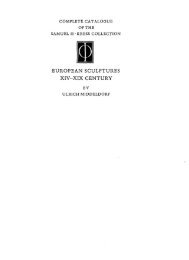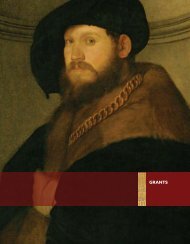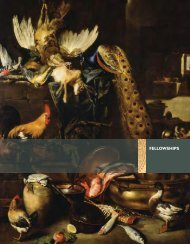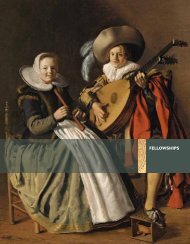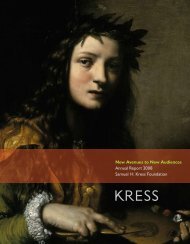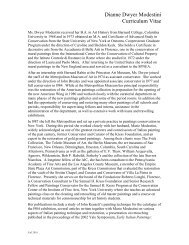The Campus Art Museum - Samuel H. Kress Foundation
The Campus Art Museum - Samuel H. Kress Foundation
The Campus Art Museum - Samuel H. Kress Foundation
You also want an ePaper? Increase the reach of your titles
YUMPU automatically turns print PDFs into web optimized ePapers that Google loves.
220 and 240 a year. At Indiana University (IU), a much larger school, the Indiana<br />
University <strong>Art</strong> <strong>Museum</strong> (IUAM) provides curriculum-structured gallery programs<br />
that reach an estimated 8,000 university students each year. <strong>Museum</strong>s are being<br />
used to such an extent that some struggle with how to meet the demand:<br />
Our problem now is we’ve become a victim of our own success. (AMAM)<br />
[Pulling people in] was so successful, I had to stop advertising. (IUAM)<br />
Demand, however, is a good problem, demonstrating the integral role of<br />
the campus art museum as an active partner and resource in academic programs<br />
at universities and colleges. <strong>The</strong> following section discusses how campus art<br />
museums and faculty find each other.<br />
Attracting Faculty to the <strong>Campus</strong> <strong>Art</strong><br />
<strong>Museum</strong><br />
“...how do we get the<br />
museum to not just be<br />
a playroom of the art<br />
department, which is<br />
a given, how do we<br />
teach other people to<br />
use it too?”<br />
In the quotation to the left, a professor is describing the role of the academic<br />
curator, 2 whose primary responsibility is to connect faculty throughout the college/<br />
university with the museum. Five 3 of the seven museums in the study are fortunate<br />
to have someone in this position, as well as a museum educator. 4 More typically, an<br />
academic art museum has only a museum educator who works simultaneously with<br />
public schools, the community, faculty, and students on campus. Whether academic<br />
or education curators, museum personnel tend to employ various forms of outreach<br />
to engage faculty in academic uses of the museum, as discussed below.<br />
New Faculty Outreach<br />
Most colleges and universities welcome new faculty to the campus through an<br />
orientation program that, among other things, introduces resources on campus.<br />
Some campus art museums work closely with those responsible for faculty<br />
orientation and a visit to the campus art museum is included in the program.<br />
Ideally, the visit is more than a simple tour. Several of the campus art museums in<br />
the study organize workshops on academic uses of the museum for the orientation<br />
program, as described by an academic curator:<br />
2. This position is also referred to as academic coordinator, curator of academic programs, director of academic programs,<br />
academic officer, and more. This report tends to use the term academic curator to refer to the person whose primary<br />
role is to link the museum with faculty and students on campus. A later section discusses the role of the Mellon<br />
<strong>Foundation</strong> in creating a cadre of academic curators.<br />
3. <strong>Museum</strong>s with academic curators included the AMAM, IUAM, the Smart, and the Spencer. <strong>The</strong> MU <strong>Museum</strong> of <strong>Art</strong><br />
and Archaeology employed a half-time academic coordinator.<br />
4. This position is variously titled curator of education, education curator, education director, or museum educator. <strong>The</strong>se<br />
terms are used interchangeably in this report.<br />
Attracting Faculty to the <strong>Campus</strong> <strong>Art</strong> <strong>Museum</strong><br />
6



